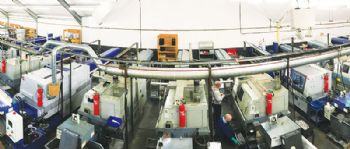
To be a competitive manufacturer of small turned parts requires not only efficient sliding-head turning centres but also investment in the very latest technology — hence Vixen CNC’s installation of high-frequency turning (HFT) software on some of its Star turning centres.
Nestled between the mountains of North Wales and Snowdonia National Park, Llanberis-based Vixen CNC is a sub-contract machinist that was started by managing director Jake Wood in 1999 with a VMC and a plug-board lathe; it achieved a first-year turnover of £50,000.
The company now has a turnover exceeding £3.6 million, 21 staff and 23 machine tools — 16 being Star sliding-head machines, of which three were installed in the last 12 months alone.
Mr Wood says: “We bought a second-hand Star KNC machine in 2000 and our first new Star — an SV-20 — in 2002. They were capable, reliable and efficient, so we bought more Star machines.
“With our increasing focus on one-hit machining, plus the need to replace ageing machines, we have been investing in the very latest Stars; we now have models with 20, 32 and 38mm-diameter capacities, and last year we bought another three new ones — an ST-20, an SR-38B and an SR-32JII.
The latter has a Y axis and replaced an older SV-32; the new machine can turn out some parts in half the time of the old one.”
With Mr Wood’s background in engineering for the ‘safety industry’, it comes as no surprise that his company manufactures parts and assemblies for the PPE (personal protective equipment) and safety sectors — in particular components for ‘height and climbing’ applications, used by both the leisure and industrial markets.
Today, some 30% of Vixen’s turnover comes from ‘safety’ exports (mainly to the USA and Europe); the remaining 70% comes from the domestic market, and it includes sub-contract work for the pneumatic, hydraulic, automotive and general-engineering sectors.
Vixen machines a wide variety of materials, including aluminium and brass, as well as 303 and 316 stainless steels. Production is on a ‘round the clock’ basis, with the Star machines running batches from 50-off to more than 300,000.
Small-batch production is run during the day, and larger batches are run unmanned at night.
Reliable production
However, the nature of the components and materials being machined by Vixen had prevented ‘’lights out machining on many parts, until Derby-based Star Micronics GB Ltd (
www.stargb.com) introduced the HFT software.
Mr Wood said: “While we generally quote a turn-round time of four to six weeks, we also offer a service where we supply urgent jobs within a week, and we have allocated machines with 12-65mm bar capacities for this work. However, the issue of swarf wrapping around tools and workpieces had been causing work-flow issues.
“For example, we regularly machine a batch of 4,000 stainless-steel safety-industry components that require turning from 8mm to 4mm in diameter. However, we could only machine 400-500 parts a day due to swarf wrapping around tools — and we had to cope with large volumes of chips filling our swarf bins.

“We had to stop the machine every few hours to empty the bin of stringy swarf — a significant inconvenience.
“Furthermore, we were frequently stopping our Star SR-20 machine because the swarf was scuffing components by catching between the tool and part — to the extent that parts were being scrapped.
Even when we didn’t need to stop the machine, stringy swarf would impede the sensors on the SR-20, giving us an M27 ‘part-off breakage’ error message.
The result was inconsistent machining performance — particularly on certain materials and processes. Moreover, even though we would empty the bins at the end of a day shift and prepare the machine for unmanned processing, stringy swarf issues would cause the machine to stop after 150-200 parts.”
Problem solver
When this problem was reported to Star’s engineering team, it suggested that the company’s HFT software would prove beneficial; the new software oscillates the tool at very-high frequency as it traverses along the surface of the part, breaking the swarf and ensuring short chip lengths.
The result on a batch of 4,000 parts was a daily production rate of 1,000 as opposed to 500, and Vixen could run the machine unmanned overnight without being concerned that error codes might randomly stop the machine.
Mr Wood said: “The installation of the HFT software on the SR-20 proved so successful that we have since added it to a second SR-20, a SR-38B and our SR-32JII.
“We aim to soon have the software on at least 50% of our Star machines, and we will certainly have it on every new Star machine we buy in the future.
“We have another batch run of 12,000 parts that are machined from 316 stainless; we turn these 60mm-long parts from a diameter of 16mm to 12mm.
“Every time we have run this job in the past, we have either had the M27 part-off breakage error or a part-ejector error — both caused by long stringy swarf. This situation limited us to manned machining during the 10hr day shift.
“While applying the HFT software means we have increased the cycle time by 12sec to just over 1min 30sec, we can now reliably run this long batch unmanned for up to 20hr a day, rather than just a few hours.
“The minimal increase to the cycle time is well worth it, when you consider that we are doubling unmanned production hours on the machine.”
In conclusion, Mr Wood says: “We have gained unmanned running on challenging jobs — and improved tool life and surface finishes, while reducing scrap rates.
“Moreover, while tool life had previously been diminished by stringy swarf preventing coolant getting to the cutting area, this is no longer the case — and we no longer have to run high-pressure coolant to help break swarf.”